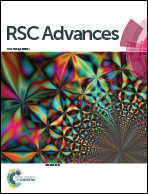Facile synthesis of porous organic polymers for the absorption of Pd(ii) ions and organic dyes†
Abstract
Porous organic polymers (POPs) were prepared via two-step reactions. In the first step, dialdehyde compounds were synthesized using the Suzuki–Miyaura coupling reaction, and in the second step, the dialdehyde compounds reacted with hydrazine hydrate to form polymers using Schiff’s base formation reactions. These POPs are nanosheet-layer structured, crystalline and fluorescent. They were studied using FTIR, fluorescence spectra, UV-Vis, SEM, TEM, XRD, DSC, and TGA. It was found that the pore parameters, such as specific surface areas and pore diameters, of the POPs could be adjusted by changing the reaction time and temperature. The specific surface areas increased with the increasing of reaction time and temperature. The maximum specific surface area could reach 715.6 m2 g−1. Furthermore, the POPs could detect and remove Pd(II) ions and organic dyes. When in contact with Pd(II) ions, the fluorescence of the POPs was quenched, and the POPs could absorb Pd(II) ions as well. The maximum absorption capacity for Pd(II) ions could reach 20.6 mg g−1 within 5 min. Meanwhile, the POPs could absorb two model dyes, rhodamine B (RhB) and methylene blue (MB), with high efficiency within 5 min.


 Please wait while we load your content...
Please wait while we load your content...